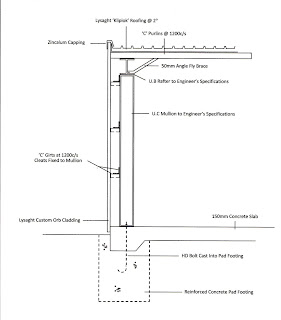
Wednesday, June 4, 2008
Tuesday, June 3, 2008
SITE VISIT 3

Below is an example of permanent bracing. The size of the permanent bracing is much bigger than the temporary bracing, and is in the shape of an 'L' as opposed to the smalled rod that acts as temporary bracing.


Bracing in between the 'C' girts is visible in the above photo, and below, fly brace between the stanchioin can be seen connecting to the 'C' girts and purlins.
 Steel plates cast into the concrete known as 'diamond dowels' can be seen above. These are to prevent the adjoining slab from rising/ or sinkning when it is poured, but allows for lateral movement.
Steel plates cast into the concrete known as 'diamond dowels' can be seen above. These are to prevent the adjoining slab from rising/ or sinkning when it is poured, but allows for lateral movement.

Monday, June 2, 2008
ARTICLE 6 - SCIENCE OF BRICK
The National Geographic channel's program 'Megastructures' covers some of the leading events in the construction industry. In a recent episode, it took a look into one of the world's first building materials, - brick.

ARTICLE 5 - WORLD'S TALLEST BRIDGE

The Millau Viaduct (le Viaduc de Millau), designed by structural engineer Michel Virlogeux, is the tallest bridge in the world.
It spans the valley of the River Tarn in southern France, and reaches a height of 343m at its highest point, making it taller than the Eiffle Tower, and only 38m smaller than the Empire State Building.
http://www.channels.com/catalog/playlist/811/megastructures#catalog/bookmark/7530/worlds-tallest-bridge
SITE VISIT 2
 The above image shows the spacing of the portal frames.
The above image shows the spacing of the portal frames.Safety mesh, 'C' purlins and bracing between the purlins is also easily identifiable.
 A close up of the knee joint, showing stiffening plates on either side of the stanchions (column) flanges, which assist in making the connection at the knee joint more rigid.
A close up of the knee joint, showing stiffening plates on either side of the stanchions (column) flanges, which assist in making the connection at the knee joint more rigid.
 The 'I' beam supporting the apex has a much smaller cross-sectional size compared to the stanchions.
The 'I' beam supporting the apex has a much smaller cross-sectional size compared to the stanchions.Haunching is also evident at the apex, helping to reduce deflection of the rafters.
 The above image shows the HD bolts which have been cast into the pad footing and secure the stanchion to the ground through a base plate.
The above image shows the HD bolts which have been cast into the pad footing and secure the stanchion to the ground through a base plate.A welded cleat is also visible and connects the pre-cast panel to the stanchion.
 The two panels in the above photo are acting as lintels over an opening. They are seated on steel cleats to support them, and then later connected by a steel plate and bolts which are secured into ferrels cast into the panels. The joint will later be covered over.
The two panels in the above photo are acting as lintels over an opening. They are seated on steel cleats to support them, and then later connected by a steel plate and bolts which are secured into ferrels cast into the panels. The joint will later be covered over.

Sunday, June 1, 2008
ARTICLE 4 - PRECAST CONCRETE
Saturday, May 31, 2008
GEELONG FABRICATORS
ARTICLE 3 - TIMBER SUSTAINABLITY


ARTICLE 2 - LVL
engineered LVL beams
e-beam is a product developed by wesbeam, and complies with AS/NZS 4357 Structural Laminated Veneer Lumber. It is manufactured from Maritime Pine veneer, and glued using a phenolic adhesive.
ARTICLE 1 - NY CRANE COLLAPSE
SUMMARY
Friday, May 30, 2008
SITE VISIT 1

The below images show the knee joint connection between the stanchion, and the 'I' beam. Due to the large span of the portal frame, the beams have been haunched (made deeper) at the supports, to stiffen the beams and reduce mid-span deflection.
Cross- bracing between the two frames and between the frames and 'Z' purlins is also evident in the photo. The 'Z' purlins, which are spaced at either 1200 or 1800 centres are used as an alternative to 'C' purlins to fix the roof cladding to.



Saturday, May 10, 2008
Sunday, April 27, 2008
Friday, April 25, 2008
PRE - CAST PANEL LIFT
 The panel is lifted at strategic points to ensure stress is equally distributed through the panel.
The panel is lifted at strategic points to ensure stress is equally distributed through the panel.


It's interesting to notice that the panel is being lifted with the temporary bracing already attatched to it.




















